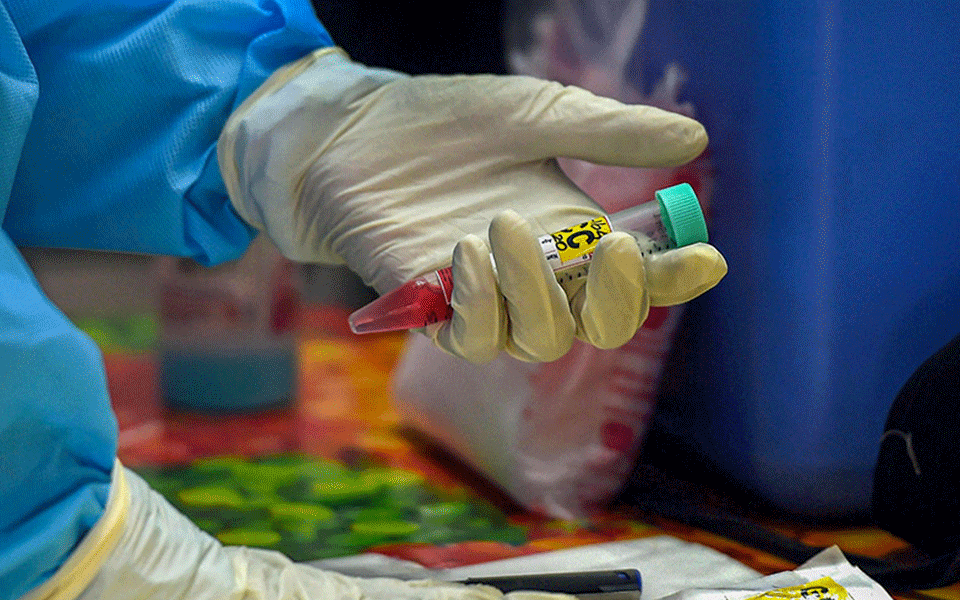New Delhi: COVID-19 patients admitted to intensive care in the early months of the pandemic experienced a higher burden of delirium and coma than is typically found in those hospitalized with acute respiratory failure, according to the largest study of its kind to date.
The research, published in The Lancet Respiratory Medicine journal, tracked the incidence of delirium and coma in over 2,000 COVID-19 patients admitted before April 28, 2020, to 69 adult intensive care units across 14 countries.
According to the scientists, led by those at Vanderbilt University Medical Center in the US, the choice of sedative medications and curbs on family visitation played a role in increasing acute brain dysfunction for these patients.
They said ICU delirium is associated with higher medical costs and greater risk of death and long-term ICU-related dementia.
Nearly 82 percent of the patients in the study were comatose for a median of 10 days, and 55 percent were delirious for a median of three days.
The scientists noted that acute brain dysfunction lasted for an average of 12 days.
"This is double what is seen in non-COVID ICU patients," said study co-author Brenda Pun from VUMC.
The scientists believe COVID-19 could predispose patients to a higher burden of acute brain dysfunction.
However, they also noted that patient care factors, some of which are related to pressures posed on health care by the pandemic, also appear to have played a significant role.
With respect to COVID-19, the scientists believe there has been widespread abandonment of newer clinical protocols that are proven to help ward off the acute brain dysfunction that usually affects many critically ill patients.
"It is clear in our findings that many ICUs reverted to sedation practices that are not in line with best practice guidelines and we're left to speculate on the causes," Pun said.
"Early reports of COVID-19 suggested that the lung dysfunction seen required unique management techniques including deep sedation. In the process, key preventive measures against acute brain dysfunction went somewhat by the boards," she added.
Analyzing patient characteristics from electronic health records, and care practices, and findings from clinical assessments, the scientists found that about 90 percent of patients tracked in the study were invasively mechanical ventilated at some point during hospitalization, and 67 percent on the day of ICU admission.
Patients receiving benzodiazepine sedative infusions were at 59 percent higher risk of developing delirium, they added.
In comparison, the patients who received family visitation were at 30 percent lower risk of delirium, the study noted.
"There's no reason to think that, since the close of our study, the situation for these patients has changed," said study senior author, Pratik Pandharipande.
"These prolonged periods of acute brain dysfunction are largely avoidable. ICU teams need above all to return to lighter levels of sedation for these patients, frequent awakening and breathing trials, mobilization, and safe in-person or virtual visitation," Pandharipande added.
Let the Truth be known. If you read VB and like VB, please be a VB Supporter and Help us deliver the Truth to one and all.
Bengaluru (PTI): Targeting Chief Minister Siddaramaiah and the Congress government in Karnataka on corruption, BJP leader R Ashoka on Friday said, being foolish was forgivable, but being "shameless" in public life was not.
The Leader of Opposition in the state Assembly claimed that in just 30 months of its tenure, the Congress administration has broken every previous record on corruption-related controversies.
He was responding to Siddaramaiah's post on 'X' on Thursday hitting back at the BJP, stating that Upa Lokayukta Justice Veerappa's claims of "63 per cent corruption" were based on his report in November 2019, when BJP's B S Yediyurappa was the CM.
"But Ashoka, without understanding the Upa Lokayukta's statement properly, has ended up tying the BJP's own bells of sins onto our heads and has effectively shot himself in the foot," the CM had said, as he accused Ashoka of foolishness for trying to twist Veerappa's statement to target the current government.
Responding, Ashoka said, "it is one thing to be called foolish in politics, that can be forgiven."
"But in public life, especially in the Chief Minister's chair, one must never become shameless," Ashoka posted on 'X' on Friday addressing Siddaramaiah.
Noting that the CM himself had admitted on the floor of the Assembly that a Rs 87 crore scam took place in the Valmiki Development Corporation, he said that when a CM acknowledges such a massive irregularity inside the floor of the House, the natural expectation is immediate action and accountability.
"But instead of taking responsibility, you continue in office as if nothing has happened. What should the people of Karnataka call this, if not sheer shamelessness," he asked.
Pointing out that the CM's Economic Advisor and senior Congress MLA Basavaraja Rayareddy had publicly stated that under Congress rule, Karnataka has become No.1 in corruption, Ashoka said, "Yet, you still cling to the Chief Minister's chair without a moment of introspection. What should the people of Karnataka call this, if not sheer shamelessness."
Senior Congress MLA C R Patil had exposed the "money for House" racket in the Housing Department and even warned that the government would collapse if the details he has were made public, Ashoka said.
"Despite such serious allegations from within your own party (Congress), you neither initiated an inquiry nor acted against the concerned minister. What should the people of Karnataka call this, if not sheer shamelessness," Ashoka asked the CM.
Highlighting the "40 percent commission" allegation Congress made against the previous BJP government, the opposition leader said, the commission that the Siddaramaiah government appointed concluded that the accusation was baseless.
"After your own panel demolished your own claim, what moral right do you have to continue repeating that allegation. What should the people of Karnataka call this, if not sheer shamelessness," he asked.
For the last two and a half years, Karnataka has been 'drowning' in corruption, scandals, irregularities and allegations across departments. Ashoka said, "If I begin listing every case that emerged under your government, even 24 hours would not be enough."
"And the most tragic aspect of your administration is this: the unbearable pressure, corruption demands and administrative harassment under your government pushed several officers and contractors into extreme distress - including the suicide of Chandrasekharan which exposed the Valmiki Development Corporation scam - a sign of how deeply broken the system has become under your watch," he said.
Instead of fixing this hopeless environment, the government has tried to bury every complaint and silence every voice, he charged.
"Being foolish is forgivable, but being shameless in public life is definitely not."
"When your own ministers admit scams, when your own advisors certify Karnataka as No.1 in corruption, and when your own MLAs expose rackets inside your departments - clinging to power without accountability is not leadership. It is shamelessness in its purest form." PTI KSU
Earlier on Thursday Ashoka had demanded that the corruption case and allegations in the state against the Congress government be handed over to a CBI investigation, citing a reported statement by Upalokaykta Justice Veerappa alleging "63 per cent corruption", following which Siddaramaiah hit back at the BJP leader.





